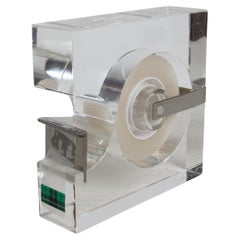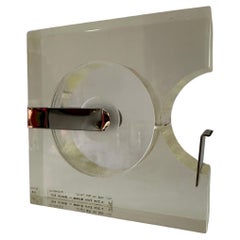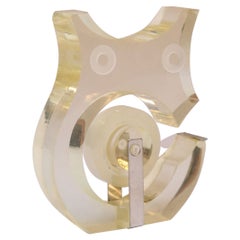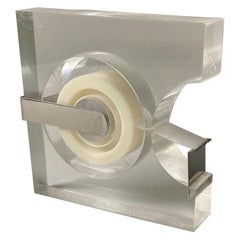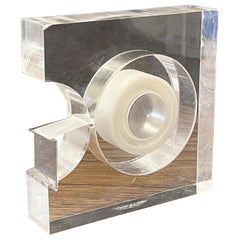Lucite Tape Dispenser
Vintage 1970s Italian Mid-Century Modern Desk Sets
Steel
Mid-20th Century American Mid-Century Modern Paperweights
Chrome
Vintage 1960s American Mid-Century Modern Paperweights
Lucite
Recent Sales
Vintage 1960s American Minimalist More Desk Accessories
Chrome
Mid-20th Century American Mid-Century Modern More Desk Accessories
Steel
Mid-20th Century American Mid-Century Modern Abstract Sculptures
Lucite
Vintage 1960s American Mid-Century Modern Desk Sets
Steel
Vintage 1970s French Minimalist More Desk Accessories
Lucite
Vintage 1970s Italian Mid-Century Modern More Desk Accessories
Metal
People Also Browsed
2010s Austrian Ashtrays
Brass
Vintage 1960s Scandinavian Scandinavian Modern Tableware
Brass
21st Century and Contemporary French Fountains
Stone, Limestone, Metal, Iron
Mid-20th Century Italian Mid-Century Modern Decorative Boxes
Metal
Antique Late 19th Century Japanese Meiji Garden Ornaments
Stone
Mid-20th Century Italian Hollywood Regency Decorative Boxes
Quartz, Silver
Vintage 1910s Japanese Showa Antiquities
Iron
Mid-20th Century English Art Deco Wall Lights and Sconces
Chrome
2010s European Mid-Century Modern Wall Lights and Sconces
Brass
Vintage 1940s French Hollywood Regency Chaise Longues
Sycamore, Satin
21st Century and Contemporary Mexican Mid-Century Modern Chandeliers and...
Wicker
Antique Early 1900s British Edwardian Cabinets
Iron
Antique Late 19th Century American Industrial Cabinets
Metal
Antique Late 19th Century Portuguese Colonial Revival Credenzas
Iron
2010s Italian Other Wall Mirrors
Art Glass, Mirror, Murano Glass
Late 20th Century Unknown Chinoiserie Picture Frames
Metal
Materials: Lucite Furniture
Antique, new and vintage Lucite furniture has been on design editors’ radars for several seasons now, but thanks to a renewed interest in Lucite coffee tables, chairs and other pieces from the late 1960s and ’70s, the trend has reached fever pitch.
“I think there’s a freshness and cleanness to it,” says Fawn Galli, an interior designer based in New York. Not only is Lucite, or transparent plastic, practical, since it can work in nearly any environment, it’s incredibly stylish.
Some of the most acclaimed furniture designers share the same love for Lucite as an effective and practical material for use in any interior.
“I think there’s something really nice about the simplicity of anything Lucite or acrylic — it feels lightweight,” says Tamara Eaton, whose eponymous firm deftly balances traditional and modern designs. Even in the most historical setting, “you can still introduce some Lucite or something kind of lightweight and not have it feel like a distinct interjection, but a playful one that’s more about the shape,” she says.
For the living room in a mid-century modern townhouse in Park Slope, Brooklyn, Eaton chose a pair of box-shaped Lucite tables with copper handles from Jamie Dietrich. “We didn’t want anything to be too heavy, and that area was a place where [the family] would sometimes move those tables so the kids could play,” she says. The tables doubled as snack trays since the kitchen is nearby. “They have this transportable feel to them that I think was really fun.”
Browse a range of antique, new and vintage Lucite side tables, table lamps and other furniture now on 1stDibs.
Finding the Right Desk-accessories for You
Whether you’ve carved out a space for a nifty home office or you prefer the morning commute, why not dress up your desk with antique and vintage desk accessories? To best tiptoe the line between desk efficiency and desk enjoyment, we suggest adding a touch of the past to your modern-day space.
Desks are a funny thing. Their basic premise has remained the same for quite literally centuries: a flat surface, oftentimes a drawer, and potentially a shelf or two. However, the contents that lay upon the desk? Well, the evolution has been drastic to say the least.
Thank the Victorians for the initial popularity of the paperweight. The Industrial Revolution offered the novel concept of leisure-time to Europeans, giving them more time to take part in the then crucial activity of letter writing. Decorative glass paperweight designs were all the rage, and during the mid-19th-century some of the most popular makers included the French companies of Baccarat, St. Louis and Clichy.
As paper was exceedingly expensive in the early to mid-19th-century, every effort was made to utilize a full sheet of it. Paper knives, which gave way to the modern letter opener, were helpful for cutting paper down to an appropriate size.
Books — those bound volumes of paper, you may recall — used to be common occurrences on desks of yore and where there were books there needed to be bookends. As a luxury item, bookend designs have run the gamut from incorporating ultra-luxurious materials (think marble and Murano glass) to being whimsical desk accompaniments (animal figurines were highly popular choices).
Though the inkwell’s extinction was ushered in by the advent of the ballpoint pen (itself quasi-obsolete at this point), there is still significant charm to be had from placing one of these bauble-like objets in a central spot on one’s desk. You may be surprised to discover the mood-boosting powers an antique — and purposefully empty — inkwell can provide.
The clamor for desk clocks arose as the Industrial Revolution transitioned labor from outdoors to indoors, and allowed for the mass-production of clock parts in factories. Naturally, elaborate designs soon followed and clocks could be found made by artisans and luxury houses like Cartier.
Find antique and vintage desk accessories today on 1stDibs.
Read More
How Noguchi Elevated Ashtrays to Objets d’Art
Smoking might have fallen out of fashion, but these ashtrays have enduring design appeal.
Jeff Andrews Captures Old Hollywood Glamour in His Cinematic Spaces
Having created extravagant homes for reality TV’s biggest stars, the designer is stepping into the spotlight with his first book.
Tapio Wirkkala Bucked the Trends of Mid-Century Nordic Design
The Finnish talent created nature-inspired pieces, from furniture to jewelry, with phenomenal staying power.
